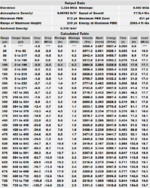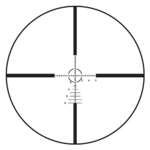Thinking about this more now and maybe you just have to limit the technique within your acceptable size hit zone. So using a deer with 8-10 inch vitals you would want to keep this where you could acceptably pick a hold that would yield that result however your reticle is configured. In my case that might mean zeroing at 440 yards. If I was to shoot anything from 330-375 and 375-420 I could hold the animal in a .5 mil bracket and score a hit, after that is center hold and so on to the aim long POA. This may not be as fast as with the box design reticle to make the decision (which I don't understand at the moment) but with a range it could certainly speed process up to getting a shot opportunity instead of establishing a dial correction for a center hold.
I am curious, and like to learn methods. Its cool the way he uses his ballistic knowledge to create and work a system. But, rubber hits the road is where I land.
I have gone through the exercise myself, thinking it through as you are exploring now, and thinking through where the system, or one approximating it would be effective. I can't see any benefit of zeroing at 440 yards and using the system for hunting. Here is an explanation of why I hold that opinion.
I and many others have come to the conclusion to zero at 100, dial on MPB zero of the rifle if the need might arise, and dial if it is further.
When it comes to shooting fast for hunting, I just can't find a system accurate enough and faster than a rangefinder that gives my my dope, like the Sig 2400 bdx paired with my Garmin 701. I can range, dial and shoot so fast I can't believe there is anything else needed. Anything faster is going to be a VERY hurried shot. Other guys have dope cards or equally fast ways to get the dope once they have a range. I know some who have shot their rifle so much they practically have it memorized.
Shooters in practical rifle matches have the ability to range the animal and shoot with a 3 mil holdover to 600 yards in seconds if they already have their position built and have had time to observe and make a wind call speed. Building a position and reading wind takes far longer than ranging and shooting.
One question with the practical application of the reticle and system to hunting (which is not a criticism of the system or reticle) is whether I would need to take a shot so fast that I don't have the few seconds to range an animal and dial or hold. That has never been my experience watching animals at long range, but I have limited experience of only a few years, plus the hours watching hunting videos, lol. I also need to positively identify an animal before I shot, and it seems like the ultrashort timeline for a quick shot makes the whole process impractical for my purposes. I suppose someone shooting pigs or other varmints would benefit from a quick system to throw lead with as great as accuracy as possible and shoot with a semi automatic.
For big game, when it comes to short shooting timelines, my buddies glassed a big deer, it went behind a tree and the glasser said shoot the buck when he comes out in the opening between the trees because it was a small window before the deer walked behind another juniper. Shooter was on the gun, dialed and ready. He saw a buck come out and killed it. The glasser then said, oops, there goes the big buck over the hill... he shot a buck, but it was a smaller one. He couldn't see anything more than antlers in his scope so he was legal, but I know guys burn buck tags on button spikes they thought were does. Target ID is such that I don't forsee the random appearance at random yards as a scenario I would face and thus need to know and practice a different system to become competent under pressure. I'd have to pass on a big game animal if it was that fast. Ambushing an animal in a narrow shooting window is different, if target ID is enough.
Here is some math to look at. Sorry, I use MOA, but I was only looking at the dangerspace and drop in inches.
The first ballistic table from JBM is for a load approximating my 7mm mag rifle. You can see if you dial for 425 yards, assuming you make a perfect shot, the bullet will stay on a 10 inch plate from 398 yards to 448 yards. As soon as you factor in 1 moa gun/shooter in the field, you decrease the danger space by a significant portion.
But, assuming a perfect shot on a 10 inch target with the scope dialed for 425 yards, you can be off by about 25 yards either way with range estimation errors. But, once you get to 550 yards, you are only in the danger space from 532 to 567 yards. That is 18 yards on the inside and 17 yards on the outside for a range estimation error. This is for a 180 vld at 3000 fps, so slower velocity cartridges suffer even worse.
Given all this math, that is why I will use the MPB zero out to 350ish and dial for everything else.
The second table I just changed danger space to 24 inches. You can see there is a dramatic difference in MPB zero and range. It is why a military context with randomly appearing hostiles in a battlefield with larger target zones and the benefits of suppressive fire, I could see some application. But, even then, instructors I have had for long range, who were deployed, use and teach what I described.





